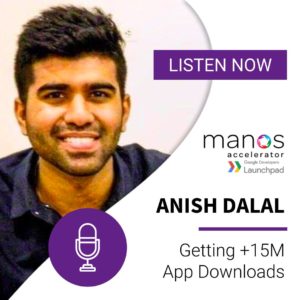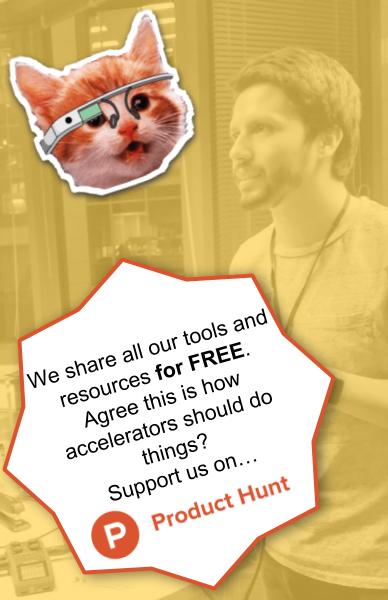 Anish Dalal is a serial entrepreneur and CEO of Sapphire Apps, a 7 figure app development and growth agency responsible for more than 15M downloads in the iOS and Google Play Stores. He has created over 500 apps for clients like Lindsay Lohan, Bart Baker, Alesso, and others.
Anish Dalal is a serial entrepreneur and CEO of Sapphire Apps, a 7 figure app development and growth agency responsible for more than 15M downloads in the iOS and Google Play Stores. He has created over 500 apps for clients like Lindsay Lohan, Bart Baker, Alesso, and others.
SUBSCRIBE
Show Notes
You are listening to the Manos Accelerator podcast in partnership with Google Launchpad. We interviewed rockstar entrepreneurs who share their exact formulas for success in customer acquisition, growth hacking, fundraising or scaling a company, and I’m your host, Juan Felipe Campos. Okay, Manos Nation! Remember for every episode there’s a giveaway of digital goods or resources from our partners that other people would normally pay for. To enter the giveaway, subscribe to the Manos podcast on itunes now and then message the word “Manos” to m.me/ManosAccelerator. Again, that’s “Manos” to the website, m.me/ManosAccelerator. To prove it.
Juan: 00:52 Today, I am with Anish Dalal. Anish what are you working on?
Anish: 00:52 So I’m currently the cofounder of Sapphire Apps and just helping people make their apps trend in the app store.
Juan: 00:58 Can you tell us a little bit of context about what you’ve worked on in terms of revenue, customer base, some milestones you’ve hit to get us context about what you’ve done?
Anish: 01:05 Sure. Um, I actually got into the app space like in 2013 I’ve built over 500 apps, I did 15 million downloads, sold that portfolio in 2016 and now helping other people get downloads. Yup.
Juan: 01:16 That’s amazing. So if I’m an app founder, do you deal mostly with B2B or B2C or B2B2C? What’s your best foot forward?
Anish: 01:25 Sure. So yeah, we probably need to deal with B2C app companies.
Juan: 01:29 Amazing. So I’m a B2C app founder. I need to increase my app downloads to either get my, either get my app profitable, which is what a lot of early stage entrepreneurs struggle with or get it to the next level. If I’m already cooking, you would be the guy to work with actually make that happen, right?
Anish: 01:46 Absolutely. Oh yeah. We dealt with a lot of apps and helping them get downloads is what we do. So um yeah.
Juan: 01:52 You guys are getting tons of downloads. What’s something, you know, if I’m in Latin America and I have a B2C product, or if I’m in the US, I’m a Latino founder, I’m trying to get my, again, my startup to the next level. What’s something you can share with us? Super tactical to make that happen for our app founders.
Anish: 02:07 Oh, absolutely. So one of the things I love about the app store the most is what people don’t focus on. And that’s essentially SEOing in the app store. So we call it ASO. So ASO is really focusing on what the key, like what key words you put on the backend of your app. So for example, in the app store you get about seven words you can put on your backend keywords and people just randomly put in words. Let’s say you have a social app, right? So most people will put in like Facebook, Instagram and whatnot. However, the key is to find keywords that will actually drive you downloads. And a quick way to do this right now is, um, you take your app and you run sample search ads to it. So the store now has a search ad platform, so you run some sample search ads to it and then once you run search ads, say about run 100 bucks, you want to download the excel spreadsheet that they give you and look at all the key words that you got downloads from and then dive deeper into those.
Juan: 03:02 Okay, so help me understand that. You’re basically what you’re doing is you’re kicking off by running a paid ad strategy and then based on the top performing ads, then you start creating an organic strategy. Exactly. That is the abstract search optimization. Exactly. Okay. So if I’m a founder and I’m looking to spend money on the paid strategy, what’s a ballpark budget range that I should be looking to spend before I have enough data?
Anish: 03:26 All you need is $100 to get started really.
Juan: 03:27 Really? Wow.
Anish: 03:31 Yeah, that’s it. And then you let the app store run its ads and it’ll run into a bunch of different places. What people don’t do is doing the followup. So once you run those ads, it’ll tell you exactly which keywords you got like rankings from. Right? So let’s say you’re a social ad and you got downloads from another Latin America social ad app that you didn’t think of to put it in your back in meta data, right? So then you take that app’s name and then you actually search it in the app store on your phone, right? And then you look at all the other apps that come up under it. So those are new keywords you can also go after because the whole goal here is to find low hanging fruit, which you want to find keywords which have high search volume and low results. And the way you can see this is just by punching it into your phone and you scroll down. If it has more than 10 results, don’t go after ’em. But what we like to do is go after new app companies that are launching, right? So let’s say a competitor has launched in your space and you want to go after their keywords because they’re probably spending a lot of marketing money, but they don’t have that much competition for their key words.
Juan: 04:35 Perfect. So it’s all about the tail end. This is something that we also talked about with Arsen and SEO. Just regular SEO, how to rank on Google, Bing. He says, yeah, you’re probably not going to be able to compete with a keyword like coffee, but you could compete for a keyword like best Colombian dropship coffee or best Colombian coffee online, east store da da da, and there’s still. Yeah, maybe there’s not 19 million web searches for it a month. Maybe there’s only 200,000, but you can still pull off a profitable business off of that 200,000 and little by little start army crawling your way to the front page. Maybe it’s going to take two years, but by the time that you’re there, you already have 2 million downloads. It took you two years and now you actually have the budget and it’s profitable enough to compete for coffee. If you try to do it from day one, you’re going to be spending $18, you know, to compete with Starbucks and they will always be able to outspend you. And that’s where we get bitter with the big established companies and we think that we need to fundraise and it’s not true. You can bootstrap it if you’re just patient and tactical enough to put in the hours and to, you know, learn more about it. That’s what you’re saying. Right,
Anish: 05:35 Exactly. And the cool thing about the app store is there’s only about 2 million apps, right? So this, for the strategies that pay off, we’re talking about months, single digit months, right? Within two months you can really get to like the top performing keywords, whereas online it might take a year or 18 months, right? There’s just not as much competition in the app store. One because there’s, there’s only about 2 million apps and two realistically, like all these big companies we’ve worked with, no one really pays attention to the keywords, right? Because they’re like, there’s barely enough room for the keywords in the backend. So all you have is your backend keywords and your title, right? That’s all you basically have in your subtitle. So people just punch in whatever they want. However, if you take like, analytical approach. So for us to come up with the keywords, it takes about two weeks and um, you know, if you really take an analytical approach to doing this, uh, you can rank very quickly, so one, um, go after the long tail keywords and the way you can measure this is, um, their sites called like Sensor Tower, uh App Store Radar.
Anish: 06:32 All these will help you measure your relevancy score for those key words. So once you start getting really relevant or basically maxing out that key word, then you take that keyword out and then introduce in more competitive keyword into your backend metadata.
Juan: 06:45 Oh, okay. So you’re actually periodically checking the keywords and once you’re already dominating one of the keywords, you don’t just double down on it. Once you’re already there, you’re already there, you’re trending for it. Now you just need to switch those out into whatever the next opportunity is.
Anish: 07:00 Exactly, exactly. So we call it, we call it a ladder building approach, so you know, rank on one and then slowly go up because like we have this one guy, so this one client, he was a betting app, right? And betting is very, very hard keyword to rank for. And his app was okay, right? It wasn’t anything special, but we did that ladder building approach. Um, you know, we did like a basketball in New York and things like that, so long tail keywords and then we slowly chopped it down to like betting in New York and then just betting, right? And then he was ranking for betting, you know, on top of people that are spending millions of dollars in marketing and well funded companies. So in the app store you can get results quickly. Um just got to follow a just slowly build that ladder.
Juan: 07:40 Right. Okay. Got It. So to take it step by step is I need to start spending at least a $100 on experiments with the paid strategy directly with the app store. I don’t need to be running Facebook ads or anything like that directly. What the app store, the app store is going to give me results based on what worked and what didn’t and the ones that worked. I need to put those as my actual official keywords in both my title, uh, the, the, what you call it, like the backend keywords, what was the appropriate term for it?
Anish: 08:03 Yeah the backend keywords.
”The cool thing about the app store is there's only about 2 million apps. So this, for the strategies that pay off, we're talking about months, single digit months. Within two months you can really get to like the top performing keywords, whereas online it might take a year or 18 months.
Anish DalalCEO of Saphire Apps
Juan: 08:09 The backend keywords so I start putting that there. The moment that I start trending under those keywords, I’m constantly running these tests. I’m constantly experimenting with App Store Radar and the in
Anish: 08:14 Sensor Tower.
Juan: 08:14 What was the other tool used?
Anish: 08:14 Sensor Tower.
Juan: 08:14 Sensor Tower?
Anish: 08:14 Correct.
Juan: 08:22 Sensor Tower. So, I’m constantly still testing with that. The moment I start trending for a keyword, then I start replacing them doing the ladder approach that you’re talking about. Little by little you work your way and it’s like you’re saying it can be single digit months, but yeah, over the next eight months, whatever, nine months, you will start getting enough traction that then it snowballs from there and then you start picking up more and more and more keywords and then you’ve got yourself enough downloads to pull off a business.
Anish: 08:43 Yeah. Um, and, and all those millions of downloads that I did before my previous one. It was just all ASO. So there’s, there’s a lot of searches in the app store themselves and it’s more easier to pull in a user who’s already in the app store than to them in externally. Right? So the whole goal is pull in all the internal users in the app store first. Once you maximize it, then go externally.
Juan: 09:01 That was huge. That was huge. So that makes so much sense. It’s way cheaper for you to convert someone that’s already in the app store. It’s already bouncing for apps. It’s already. Look, they have the intention to download an app right this second in your niche than it is for you to try to pull someone in from Facebook or from Google. That makes a lot of sense. Let me throw you a curve ball question here Anish. What happens for. So there are, this works perfectly fine if I have a utility app that it doesn’t matter if I have one download or a million downloads, it works fine like a calculator, you know a game where it’s like single player. What happens when it’s a double sided marketplace or it doesn’t work well, if I don’t have enough people, and I have to snowball really quickly. What a lot of founders do, is they focus geographically on one location, so like let’s say like the Uber of pillows and I’m just going to start off in the Tampa Bay area and then grow from there. How do you actually take into consideration the fact that some double sided marketplaces, some apps have to start off with a geographical focus before they take over more and more.
Anish: 10:01 Okay. So in double sided marketplaces, it’s very interesting. The apps that have succeeded the most in the app store. Actually what they do is they focus on either the demand or the supply and they introduced the utility inside of the app. Right? So a really good example is the app called Thumbtack and Thumbtack um basically what they do is they connect contractors with, um, people who are looking for contractors. Right? So when they started, what they did was they made a utility for contractors. So they made a time tracking system for contractors. So utility apps are much easier to push. The two sided marketplaces are branded apps, right? So they were able to push the time tracker for contractors. Once they’ve built up that supply, then they just ran marketing spend on the demand side. Because if you have the contractors there, you can bring in the demand side quite easily, right? Because the supply is there. So the best thing I’ve seen in the app store is if you ever double market a two sided marketplace, make sure you have a utility in your app so you pull them in, you pull on one side with the utility and then you just focus on the other side. And that’s whats. That’s what we’ve seen usually works.
Juan: 11:08 Let me tell you what is my favorite part about what you just said. Anish. Is that founders and for anybody listening, like founders are typically looking for growth hack to fix something that they already built that they already have and we are typically very reluctant to actually do the right thing which is take a step back and consider if the problem is actually deeper or before where you’re trying to solve it. You know, we’re trying to solve some of these problems with a bandaid or you have a gaping wound that’s actually much earlier on and I love that. Your answer wasn’t just, Oh, well then do this other thing with this other tool, and then everything’s gonna be fine. It’s probably not going to be fine. You actually messed it up. You should have built a utility first to make sure that you collect enough people on one side of the marketplace and then be able to target the other side.
Juan: 11:52 It’s we’re, we’re past the stage where like, oh, I’ll just build the Uber of tacos or the Airbnb of pillows or whatever, and then I’ll be able to generate both demands on both sides. That used to work really well when the idea itself was enough to get you the funding that you require to build out both sides of the marketplace, but now investors are looking at you saying, hey, this is too risky. I’ll let you build the inventory first. Once you’ve got traction, I’ll jump in and founders are saying without your chicken and the egg man, because without your funds I won’t be able to get enough traction to then to be able to get more funds. And, Anish’s answer, just said it right there like you actually messed up by trying to do it that way. If we have more patients and separate our startups into phases and say phase one utility phase to roll out the double sided marketplace, you’ve got a much better chance of pulling off a business.
Anish: 12:38 Yeah. And, and like the, the other thing I would say to that is it’s all about building an MVP product for the app store. There’s too many people just spending too much money and just going after the app cold. A new thing Apple has recently released that’s really beneficial is um, the let you essentially get preorders for apps. So we’re actually using that internally. So what you can do is you can essentially launch an app without having the code for the app. So what we do is, so you know, we own some like really good food Instagram pages, so you know, we see opportunity in that space, right? So instead of making the whole app, what we’re gonna do is we’re going to make a sick app icon. We can make sick screenshots and we’re gonna make sick descriptions, right? And then we are going to launch the, the preorders so we can do up to 90 days if we get critical amount of downloads, then we’ll hire, you know we’ll tell our teams to build out the product.
Anish: 13:25 If we don’t then you know, it’s okay, we’ll move on to the next thing. So that’s been a really good way. You can test ideas now in the app store is just launch it and just have an awesome external assets and then you know, run ads to it, do whatever you were going to do anyways to the app and see if they convert. So what happens is, although downloads that you get um count on the first day of launch, so I would essentially go to the app store and it says, get I click get, but the app won’t download today, it’ll download when you launch it. Um, and then yeah, you can see downloads coming in everyday. So you can say, hey, this is a good idea, or this is a bad idea.
Juan: 13:59 That’s amazing. What’s the best resource to be learning more about these things about app store optimization, driving app downloads?
Anish: 14:07 Sure. Um, so if you essentially search ASO in Google, there’s about like five, six tools that dominate the space and other blogs are really helpful. And um, that’s one and two, just if you want, you just make a simple app and try to promote it with an app store, search ads, the experience was worth more than anything. Those blogs have.
Juan: 14:31 Amazing. There you have Anish just shared some serious knowledge with us. If you have a B2C app product, a tech product that you’re trying to drive downloads to Anish is the man to learn all these things from. Over 50 million downloads, he’s helped create over 500 apps. You heard it here first.
Juan: 14:50 Okay, Manos Nation! Do not forget your chance to win goods and resources on every episode right here on the podcast. It’s very simple. You just subscribe to the show on iTunes in. Once you’ve done that, message the word “Manos” to m.me/ManosAccelerator. Subscribe on iTunes and then message Manos to the website, m.me/ManosAccelerator. See you on the next one.
Juan: 15:17 Anish, what’s the best way for people to get in touch with you and learn more about what you’re doing?
Anish: 15:21 Sure. Um, you can add me on Linkedin. My name is Anish Dalal or you can, um, yeah, just reach out to me on Facebook or anything. Any of the social platforms are good. So yeah, feel free to reach out and I’m looking to help anybody who needs help in the apps biz.
Social Media:
Resources:




